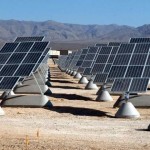Solar Power Coming to Texas in a Big Way, Part One

Robert Menard,
Certified Purchasing Professional,
Certified Professional Purchasing Consultant, Certified Green Purchasing Professional, Certified Professional Purchasing Manager
Editor’s Note: this is the first of a two part series on the near future of solar generated electricity in Texas, a state famously known for its oil and gas energy. This Part deals with the landscape, quite literally, while Part Two looks at applications.
As any proud Texan knows, we do things here in a big way. Alaska likes to brag about it’s size, but we have more residents in the City of Dallas than the Alaskans have in their entire state. DFW airport is so large, that JFK in New York, ORD in Chicago, and LAX in Los Angeles fit inside its footprint, with plenty of land left for natural gas wells that yield millions in revenue per year. God bless Texas!
So why is the leading state in oil and gas energy production looking at the solar alternative? Because it is Texas and we believe in free enterprise. Texas has led the country in job generation during the Obama recession and it will soon surpass California as greatest green energy producing state in the Union.
Solar power generation on an industrial scale has been limited to sites in California, particularly the Mojave Desert. The Ivanpah Dry Lake Solar Electric Generating System is one example. The southwestern Texas regions have vast stretches of land that resemble the Mohave in terms of geology and meteorology. The generally flat terrain, usually cloudless skies, and abundant sunshine throughout the year make thousands of square miles suitable for solar energy generation. Especially for urban dwellers, if you have ever enjoyed the good fortune of driving through the desolation of the Mojave or the 300 miles emptiness of I-10 from El Paso to Midland, or for that matter 100 to 200 miles north or south of I-10 in SW Texas, you were doubtless stunned by the beauty, serenity, and ennui of the land that rolled away under your wheels. Nevertheless, this barren and inhospitable landscape is ideal for solar power creation.
Plans for Texas solar are as big as the Lone Star State
Solar (Photovoltaic) technology is advancing rapidly on a global basis, especially where the heavy and inept hand of government does not tamper with the market. Greater choice and lower prices always proceed from free markets. Texas is soon to announce its solar presence to the energy consuming world.
Already, a solar firm that exceeds thrice the size of any existing plant is underway in the Lone Star State. What is more, lucrative subsidies that drive solar development in states other than Texas. Jams Osborne, Energy Reporter for the Dallas Morning News wrote in a 05 June 2014 story that almost 400 megawatts of capacity are under construction, permitted, or proposed through 2106. Osborne attributes a quote to Arno Harris, CEO of Recurrent Energy, based in San Francisco, CA as saying, “It’s really just economics. The solar industry has driven prices down to where solar can compete.” Harris cited a 60 to 70 percent drop in the cost of solar generated electricity, mostly attributable to advancing technology and global competition.
Osborne claims that Texas accounts for almost the lowest per-capita solar power usage in the US, a statistic that will soon change. Recurrent plans to build a 150-megawatt solar farm in western Texas. First Solar based in Tempe, AZ, has begun construction of a 22-megawatt farm near Stockton. Expansion plans call for a 150-megawatt ultimate build out. By way of magnitude, one megawatt can serve an average of 200 residential properties.
Counting isolated rooftop solar panels and a 39-megawatt facility operation in San Antonio, Texas currently has less than 220-megawatts of solar power. Almost 350-megawatts of solar are set to be built and operational by 2016, over a 150% increase in just two years. Another 2,000-megawatts in solar farm applications have been filed with the Electric Reliability Council of Texas (ERCOT).
Even the US army is getting into solar power. In 2013, Fort Bliss hired El Paso Electric to build a $120 million plant and will sell the power generated by the plant to Fort Bliss at a set price. The 20 MW solar farm will provide about 14 percent of the base’s energy needs.
Click here to learn much more about Texas solar from the Solar Energy Industries Association.
